Winter's Wrath - Winter's Wonder
by Jim Moerschel

It is night! Old man winter comes in, first as
a demon, with swirling snow,
frozen rain and howling winds. Then, after what seems a millennium of
white
fury and natural chaos, the wind stops, the snow and sleet subside and
soon it
is daybreak. With the first glow of light the spectacle of the storm is
gently
revealed. Then, suddenly, like a theatre curtain, the remaining storm
clouds
part, the first rays of sunlight gently touch the virgin landscape - revealing
a
shimmering winter wonderland.
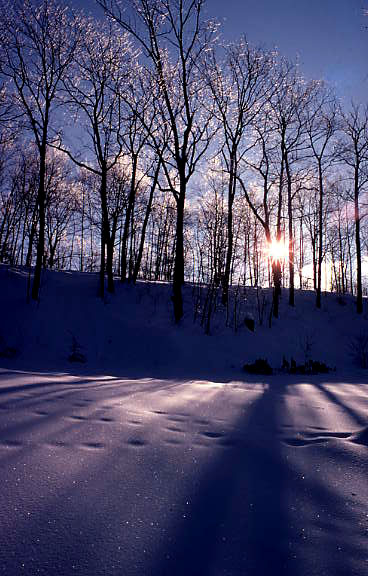
When the slipping, sliding and shoveling is over,
I find myself trudging
through a foot of ice-encrusted snow, up the sloping hillside to the field,
now a gleaming amphitheatre. Half blinded by the glaring light, I can
barely
see the carnage of the storm. There in the snow-covered field lay the
skeletons,
the twisted and broken remains of milkweed, ferns, goldenrod, thistle
and other
remnants of summer past; but a closer look reveals that each of them has
been
transformed from mundane, drab forms into glorious ice sculptures.
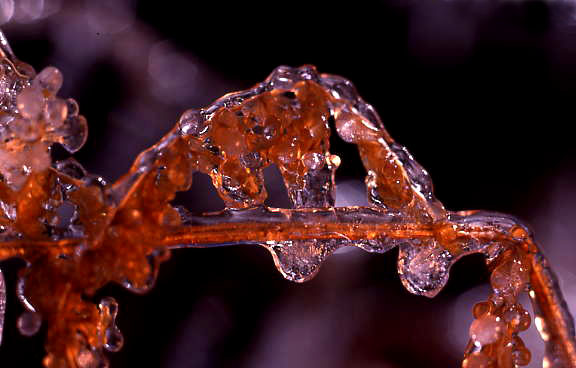
The panoramic vista of glistening ice is so overwhelming
that the initial
temptation is to try to capture as many wide-angle views as possible and
my
24mm does the job nicely. However, I've been more fascinated in recent
years
with finding and composing the tiny ice sculptures into "macro scenes"
that
are just as beautiful and powerful as the overall big picture.
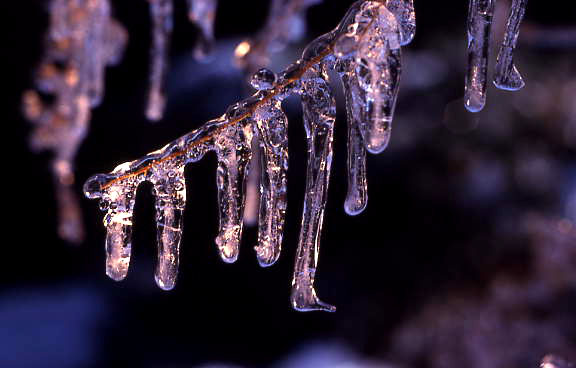
The snow drifts depths vary with uncanny regularity
and I find myself
walking easily in six inches of virgin snow one minute, only to plunge
into
a three foot drift the next. This is where the tripod comes in handy.
I use
it as a snow probe to avoid the unpleasant surprise of a steep drop off.
suddenly, my eye spots my first subject, an ice coated milkweed stalk
and
pods.

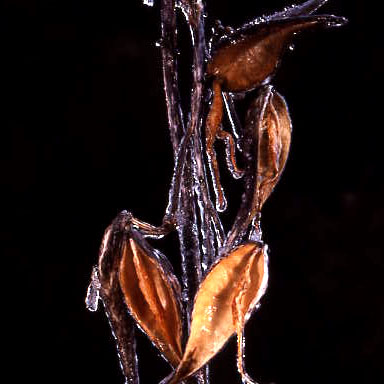
Only a couple of months ago, on a crisp autumn
morning, I stood in this very
section of the field photographing a large colony of milkweed pods and
their
photogenic seeds. Now, in the aftermath of the furious storm, only a few
stalks
and pods remain above the blanket of ice and snow. However, the few that
are still visible have such an eye-catching appeal, that I decide to take
a peek
through the macro lens and I enter the Lilliputian world of ice crystals.

All the while I've been tramping around through
the snow, my camera has
been carried around my neck for quick access, but inside my warm parka
to
keep it relatively warm. In years past, I used to only use an older generation,
manual camera on these extremely cold days. My old Nikkormat never froze
up or let me down when I needed to get the shot. However, my new generation
cameras, such as the Nikon N90s that I've used for the past 5 years or
so,
has always performed well in extreme cold. Even so, I keep the camera
tucked
inside my parka to keep it warm until I'm about to shoot.
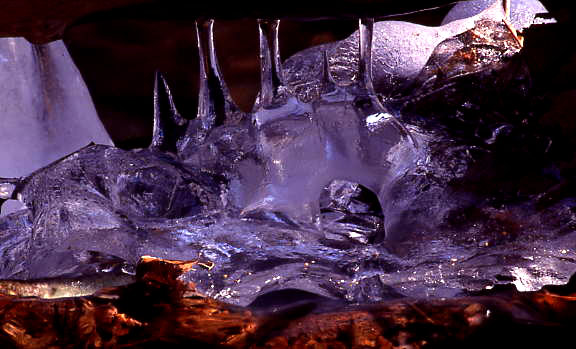
It's also a good idea to mentally work out all
the possible angles of shots of
the subject before actually moving about. This helps reduce the possibility
of
slipping or falling with your camera gear in icy conditions. Once I've
decided
on the most photogenic view of the subject, then I'll move the tripod
into position
and make final adjustments.
Most times when photographing nature's still life subjects, I prefer natural
lighting. However, the most photogenic angle of view may not coincide
with
favorable lighting conditions or a pleasing background. So, I must find
solutions
to these challenges.
The use of electronic flash or reflectors or a combination of these devices
can be used to add dramatic light on a dull, overcast day, or in situations
where I want to eliminate an unwanted background of un-photogenic material
that would ruin the visual impact of the scene.

With my 105mm macro lens precisely focused and
the flash held off camera
and to one side, I place the reflector opposite the direction of the flash
to soften
shadows and model the subject. I make several exposures, changing the
position of the reflector with each set of "takes." The final
photo shows brightly
illuminated pods set against a poster-like dark background, which I feel
was
more desirable than the jumble of weeds and branches that would have created
a distracting and confusing background.

I move on in search of more sculptures and I
find a broken branch from an
oak tree. Still attached to a twig is a single leaf gleaming in the warm
toned,
early morning light. No need for flash this time. It was beautiful back-lighting
of the leaf that had caught my eye and I was comfortable with the natural
background as well.
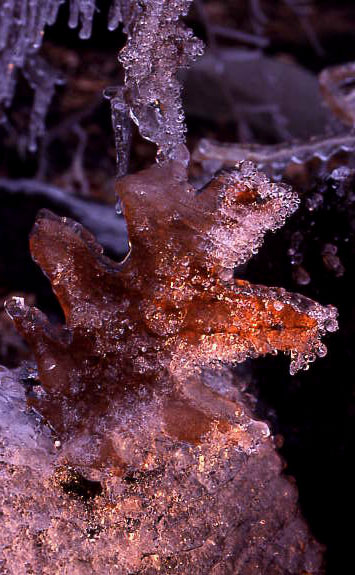
This time the subject was right at ground level,
which means that the camera
has top be supported as low as possible. The super clamp made by Bogen
does
the trick. It allows the camera to be clamped to the leg of my tripod
right
where I need it, down very low. I have a ball-head attached to the super
clamp
and this allows me to use the camera in both the horizontal and vertical
format.
Now the hard part. I've got to lie down inorder to peer through the viewfinder.
That means being prone on frozen turf. It would be an asset to be a contortionist,
but I try to make the best of the situation. I add a reflector for some
additional
highlights, then compose the image and make the shot.

In metering the snow, there are a few things
you can do. I do carry an 18
percent card in my backpack. It's very simple to lay the card right next
to the
tiny scene before you and take the camera meter reading right from the
card.
If there is a "medium" toned log, or tree trunk in the same
light as your tiny
scene, then meter off those objects. Or you can meter the snow itself
and open
your lens f stop by one and a half stops to gain a correct meter reading.
Always
bracket with extra shots in these tricky lighting situations.
Before taking the shot, check your depth of field. This button is one
of the
most important tools on your camera. It allows the photographer to see
the
final image at "taking aperture" before pressing the shutter
button. Adjustments
can be made by changing the f stop ring.
On days like this, finding subjects can be quite easy, as a matter of
fact
there may be an overwhelming number of them. Just look around at all the
pinecones, thistle, barberries, sumac, acorns, leaves, branches, ferns,
and lots
of saw-toothed icicles that now have become photogenic jewels just waiting
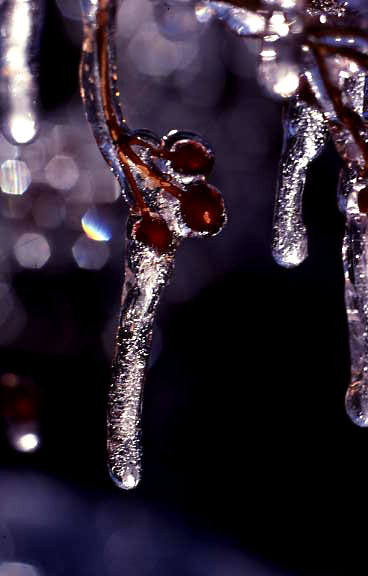
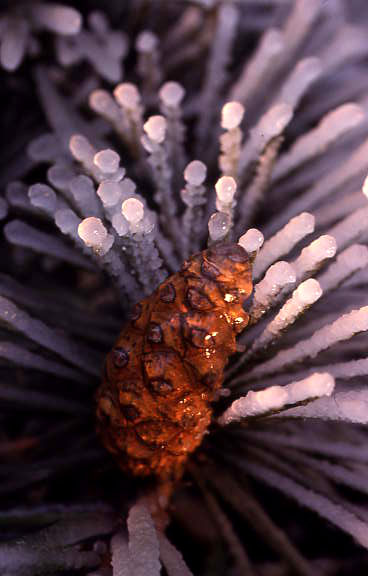
for someone with a camera to come along and capture
them one by one.
As I walked through a part of the field where the twisted remains of ferns
lay mangled in the icy snow, I spotted a real gem. Encased beneath a gleaming
ice formation was a twisted fern. The angle of light illuminated it perfectly.
The scene through the macro lens was purely magical. The remnant of the
delicate, lacy frond was covered with frozen diamond-like droplets.
I was viewing nature's majestic, golden necklace draped in its icy showcase.
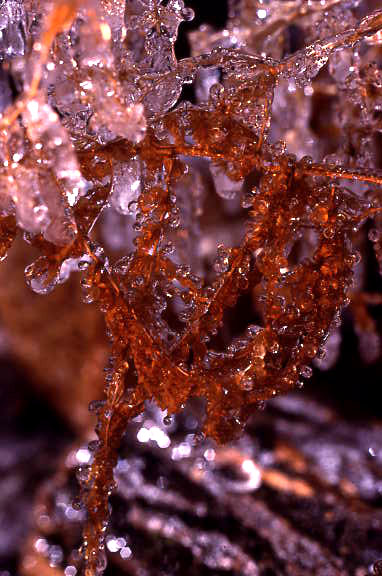
I made my first image. Then I added an extension
tube to increase the
magnification. Now I was exploring worlds within worlds. Tiny ice bubbles,
seeds and other minute subjects now came into view and frame after frame
passed the shutter.
finally, I stopped taking photos. Had my mind finally agreed with my frozen
body and decided that it was time for a comfortable chair in front of
my fireplace
and a cup of hot coffee? Not really. I just ran out of film.